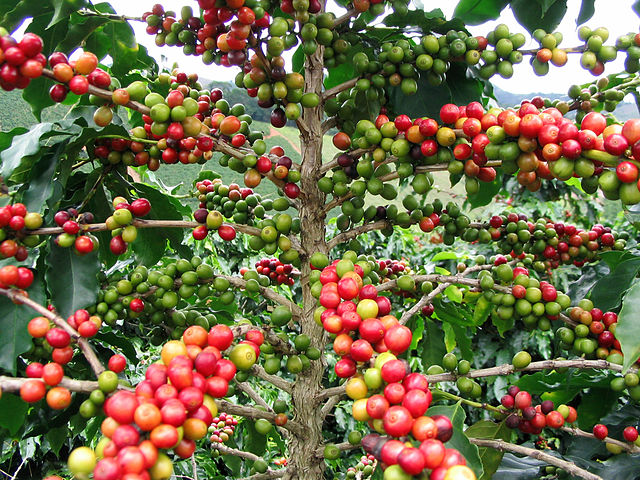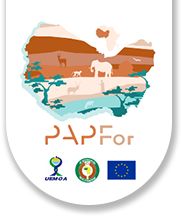Home / Guinean forests / Threats / Deforestation for agriculture / Agriculture for agro-industry / Coffee
Coffee
Coffee trees are shrubs of the genus Coffea, which has many species (over 130). Two of these, Coffea arabica and Coffea canephora, originating in Africa, are cultivated for their seeds which, once roasted, are combined with almost boiling water to produce the drink coffee (from the Arabic ‘qahwah’, meaning tonic): the first produces Arabica coffee, the second Robusta.
Green coffee is not a variety of coffee, it is the unroasted bean. The tree produces fruits, cherries, in the centre of which is a core made up of seeds. These are the green coffee beans.

Coffee "cherries" - containing the seeds - ripening on a coffee tree (https://commons.wikimedia.org/w/index.php?curid=134763)
Green coffee is one of the most important cash crops in the world. The Guinean forest countries are among the largest producers.
| World Rank | Country | 1961 | 1980 | 2000 | 2018 |
| 15 | Côte d’Ivoire | 185 500 | 249 609 | 380 000 | 88 867 |
| 24 | Guinea | 15 000 | 14 400 | 22 080 | 42 900 |
| 26 | Cameroon | 44 700 | 112 207 | 86 200 | 33 164 |
| 29 | Sierra Leone | 5 103 | 10 146 | 15 000 | 28 096 |
| 32 | Togo | 10 300 | 10 385 | 15 200 | 21 023 |
| 52 | Nigeria | 1 100 | 3 500 | 3 830 | 1 849 |
| 54 | Ghana | 1 700 | 1 500 | 1 956 | 735 |
| 55 | Liberia | 3 400 | 12 742 | 3 127 | 648 |
Country ranking by green coffee production (in tonnes) - Source: ‘Coffee (green)’, FAOSTAT, FAO, UN - https://atlasocio.com/classements/economie/agriculture/classement-etats-par-production-cafe-vert-monde.php
The ecological impact of coffee production and consumption is of great interest: new monoculture plantations, the evolution of agro-forestry systems towards a monoculture with little shade, high water consumption, the use of pesticides, soil conditioners and fertilisers are drawing increasing criticism. Even though the scale of encroachment of coffee plantations into Guinean forests is is rather small compared to cocoa, it is a real threat because it leads to net deforestation and the spreading of pesticides that enter ecological cycles of neighbouring forests and waterways.

